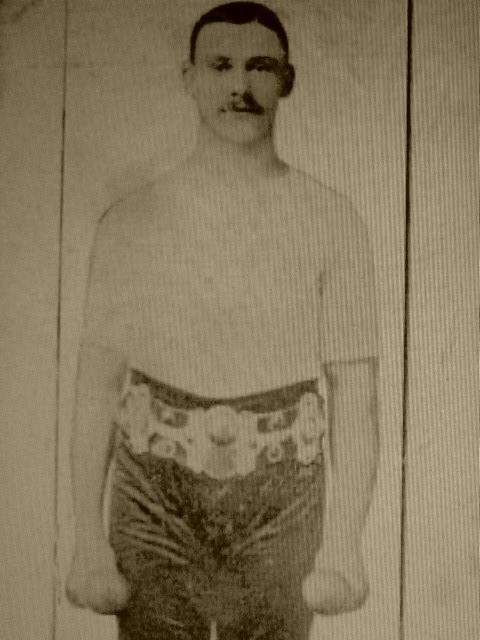
JOE DARBY
Windmill End in Netherton, which abuts the Dudley number 2 canal was the birthplace in 1881 of Joseph Darby. By his own admission, Joe did not have much schooling, in fact starting work in a nail-making shop at the age of 7 (his father had been a nail-maker, although that line of work was paying less and less in the second half of the nineteenth century, more of a secondary source of income earned by the women and children of the family). But he developed a flair for athletics and in between working unloading boats and black-smithing he started to earn prize money in organised events in the Midlands and the North. His speciality was ‘spring’ jumping from a standing start, often using dumb-bells for momentum. Between December 1887 and March 1888 he defeated the American ‘world champion’ spring jumper three times in a row, leading to him being recognised as the undisputed world champion. The American – W.G. Hamlington, or Hamilton depending on which source you take – was over here touring with Buffalo Bill’s Wild West Show, and their first meeting took place in Manchester, where Darby won in an event which consisted of ten spring jumps in a row. The American was touring under the name Mustang Jack: one of his famous fellow entertainers, other than Buffalo Bill himself, was legendary Sioux chief ‘Sitting Bull’ who was murdered by reservation native police almost exactly 3 years later.
In Black Hearts And Blue Devils, Joe Darby is getting in a spot of training at Windmill End when he is interrupted by a visit from the police – what that is all about you can discover by reading the book! Another character, Stephen Vyle, is saving to go and see the Wild West Show. To complete the USA connections, readers of these posts will be aware that a local pony in the story has been named after the ‘sole survivor of Custer’s last stand’ – Comanche the horse (as featured in the 1960 Johnny Horton recording). And there is also an American ‘witch’ who assumes the name of Molly Mogg. More of her in another post perhaps. Attached is an image of Joe: wearing a belt which is presumably the one awarded him in 1889 at the Dudley wake/fete. Followers of the Facebook page Black Hearts And Blue Devils can see further pictures, of the Windmill End area as it looks these days, and of Joe’s statue in Netherton.
There’s not much to see at Windmill End itself these days – as mentioned in a previous post, the old Dry Dock pub with its famous cow pies is long gone. But the reclaimed land around it is now a pleasant little park/nature reserve. On the waters around there I have seen, amongst the more common water-species, kingfisher, goosander, dabchick, heron; whilst the skies are patrolled by buzzard, kestrel and sparrowhawk – a far cry from the scene described for Joe’s days in the book.
Post Views : 492